by Eric Meier
In the world of acoustic guitars, perhaps no other tonewood holds the same respect and downright mystique as Brazilian Rosewood (Dalbergia nigra). Yet paradoxically, the wood has been virtually loved to death: since 1992, it’s been on the CITES Appendix I, the most restrictive category of endangered species, (even finished products may not cross international borders). Because of these protective measures, several substitutes have been used in recent years, primarily East Indian Rosewood (Dalbergia latifolia). Hence, for a multitude of reasons, differentiating between true Brazilian Rosewood and many of its close cousins can be very useful.
Brazilian Rosewood |
vs |
East Indian Rosewood |
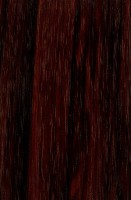 |
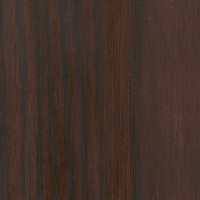 |
|
| Color: Tends to be more variegated, and more on the reddish side. (Can also exhibit a figure in the grain similar to Ziricote that is known as “spider-webbing.” | Color: Tends to be a dark chocolate or purplish brown. | |
| Average Weight: 52 lbs/ft3 (835 kg/m3) The two weights are so close, for all intents and purposes, density is identical. | Average Weight: 52 lbs/ft3 (830 kg/m3) The two weights are so close, for all intents and purposes, density is identical. | |
| Scent: Has a distinct, rose-like scent when being worked. | Scent: Has a distinct, rose-like scent when being worked; some find its scent less pleasant than other Dalbergia rosewoods. | |
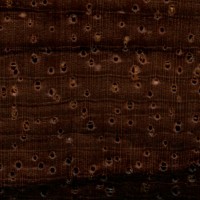 |
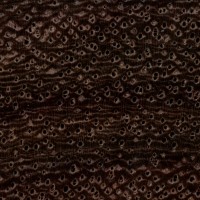 |
Endgrain: Pay close attention to the endgrain, as it’s one of the best ways to separate the two woods. Each sample above represents approximately a 3/8″ square section of endgrain. The key is in the pore density: East Indian Rosewood has about twice as many pores per square inch as Brazilian Rosewood. This can be difficult to gauge if you don’t have any known samples to compare, but Brazilian Rosewood should have fairly sparsely spaced pores, while East Indian Rosewood should be almost riddled with pores.
Another Useful Trick
Apart from the very characteristic odor, (which should roughly separate it from most non-Dalbergia species), Brazilian Rosewood has another characteristic that can be leveraged in order to help distinguish it from other rosewoods: its heartwood extractives are not water soluble, and will not fluoresce under a blacklight.
Before you get scared off from performing this test, be aware that with a simple blacklight bulb available in any hardware store for only a few dollars, and a few minutes of your time, you can perform both water extract fluorescence and ethanol extract fluorescence tests at home!
For suspected samples of Brazilian Rosewood, take a small test tube or other small transparent container and fill it with some shavings, (a handplane works great for this), and then fill the remainder of the container with water and shake it up for a few seconds. Bring the container under the blacklight and observe the results: true Brazilian Rosewood (Dalbergia nigra) will not fluoresce or show any appreciable change of color under the blacklight, while most other rosewoods will glow a pale blue/green color.
Telling Brazilian Rosewood apart from other common substitutes:
Non-Dalbergias: Use scent to rule out most non-Dalbergia species. (Scents are difficult to describe in words, but certainly no scent at all would be a negative sign.)
East Indian Rosewood: Pore density; water extract fluorescence
Amazon Rosewood: Density—Amazon Rosewood tends to sink in water; water extract fluorescence
Madagascar Rosewood: Water extract fluorescence
Cocobolo: Density—Cocobolo tends to sink in water; water extract fluorescence
Kingwood: Density—Kingwood tends to sink in water; pore size—Kingwood’s pores tend to be smaller; water extract fluorescence
Honduran Rosewood: Density—Honduran Rosewood may not sink in water, but it is roughly 20% heavier; pore size—Honduran Rosewood has slightly varying sizes of pores (ranging from medium-small to large); water extract fluorescence
Are you an aspiring wood nerd?
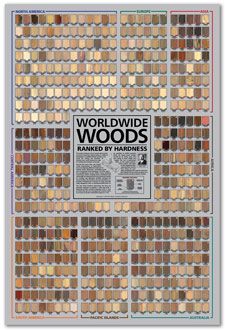




At the moment, I am moving the wood that I have collected over the last few years to my new guitar workshop. I’m not sure about the type of wood shown in the image. Does anyone have an idea about this wood?
This is a 1982 Mafred Petz accoustic that I had made for me when living in Germany then. A local luthier here in the US told me it is Brazilian based on actual inspection but via these photos a German luthier said it was Indian. Brazilian or Indian opinion?
I’m interested in opinion on the back wood for these two instruments.
#1 – 1995 Japanese. Labelled “Jacaranda”. I’ve seen the discussion around controversial naming for Jacaranda, Rosewood – Brazilian vs other rosewoods… what jacarandah is this likely to be? or is it “non-BRW rosewood” (or BRW)?
#2 – 1960s Japanese. Labelled “Brazilian Rosewood” – do you agree?
another picture of Guitar #1 “jacaranda”
Hello Eric (and rosewood aficionados), I’m hoping to get your opinion on what type of wood this guitar seems to be (back and side in photos) – rosewood? East Indian, Brazilian, ? Thanks for your help!!
I am helping the widow of a well known Japanese violin maker sell some rosewood classical guitar wood (his early training was as a guitar maker in Japan and later moved to Italy, studied in Cremona and had a storied career in the violin world). It was purchased from Fuchs in Germany in 1976. (He made guitars there for some of the leading luthiers to support his family while in Italy). I believe it’s Brazilian judging from who he purchased it from and when he purchased it. Any thoughts?
Could I please ask for some help identifying this rosewood?
Thank you in advance!
Hi,
while thicknessing the back plate for my guitar build I noticed a yellowish discoloration in one end of the indian rosewood. A bit difficult to photograph, but it is definitely there.
Is it natural occurring in the wood – or do you think it has been stained by mistake?
Thanks
Philip
In my experience this sort of variation in freshly sanded rosewood is common. (I’ve seen it most often in cocobolo.) The color variation usually just sort of goes away on its own, usually within a few days to weeks.
Hi Eric,
Thank you for the information!
This information about fluorescence was very helpful. Thank you, Eric. I tested two boards that were supposedly Brazilian rosewood against one that I know is Brazilian. After a 5min soak, the two boards that I was curious about proved to be something other than Brazilian rosewood. The water turned almost milky with fluorescence, whereas the true Brazilian remained relatively free from fluorescence. Photos attached… the two with “Doc” in the title are the non-Brazilian woods.
Hi!
I try to determine the wood and I would appreciate any second opinion on that. I attach few photos:
1) board from top
2) end pores (10x) magnified
3) from the side, pores visible
4) piece under blacklight in water
I do not notice any scent. Could this be Brazilian?
I was told that this is Rosewood, do you think so to?
Most definitely not
This is Brazilian Rosewood.
This is Brazilian Rosewood, yes?
no It looks much more like East Indian Rosewood
Does anyone know anything about Arizona Rosewood, as wood, not as a plant?
SINKER Rosewood? I am told there is some Sinker Honduran Rosewood, and it is being made into guitars. Has anyone ever heard of a Sinker Rosewood log?
3 of my 4 rosewood snares. Brazilian, and the other 2 being variants of Santos Rosewood I believe. The Brazilian is absolutely stunning!
I absolutely consider myself a wood nerd. Thank you for all the work you’ve done on this site. I am a “beginner” wood nerd–having begun educating myself about 10-15 years ago in my mid 60’s. A lot of my focus has been guitars, because I grew up playing. However, I realized 10-15 years ago that my biggest fascination was how guitar-makers use wood. The creative use of woods and integrating different woods into new designs is fascinating to me. I have gone against one of the codes of guitar playing by buying guitars because they’re beautiful without concern for how… Read more »
Jacaranda is the Brazilian name for Brazilian Rosaewood
“Jacaranda”, “jacarandá-mimoso”, “caroba”, “carobinha” or “carobaguaçu” is the common name of several species belonging to the Bignoniaceae family, which should not be confused with the jacarandá-da-bahia (Dalbergia nigra) or the jacaranda-paulista (Machaerium villosum), both from the Fabacea family.Source> Wikipedia
Hello! I was gifted a 1974 Jose Ramirez 1a and I’m having trouble identifying the type of wood used for the back and sides. I think it is a rosewood and it might be Brazilian. Please let me know if you have any ideas! If you have any additional information about how to identify this guitar please let me know! I see a signature, but no initials, and from what I can tell this guitar might be quite valuable. Thanks for your help!!
That looks like Brazilian to me, but I have seen some east indian that looks like that. – a give away is smell, if you can get a reference of either brazilian or east indian and smell it then stick your nose in the sound hole – the odour or Brazialian is unmistakable.
Also if you contact Ramierez guitars and give all the information on the label they probably have a record and can tell you.
Please look at this image and tell me if you think this is brazian rosewood fretboard
I can’t ID the wood from this picture, sorry.
No. It almost looks like Pau Ferro. Could be Indian in bad lighting.
Indian …
Could you tell me if the image on the left is brazilian it has a sweet smell and the other doesnt the one on the right I mean
Rosewood shouldn’t have a smell after being worked. The odor doesn’t linger that long like some other aromatic woods like cedar.
Hi Eric,
I’ve been building guitars for 50+ years and I disagree. The odor in the box of a guitar can linger for years. Not strong like cedar but I can usually tell instantly if a guitar is made of Brazilian rosewood from the odor.
Can you tell me if one of my fretboards is brazilian rosewood
Looks like those pics are out of focus.
Can anyone tell whether this 1980 Rosewood drum a Brazilian one or not? Coz this drum has a more reddish color than later version and looks like the above sample photo. Thank you very much!
Any thoughts on whether the wood on this early 1970 Martin might be Brazilian rosewood? Thank you for your thoughts!
Looks like Indian rosewood to me. Grain is too uniform for Brazilian.
Thanks George, you confirm my thoughts. Color wise it resembles Brazilian in some areas. I know the owner of the store picked it out special for the person I got it from in ‘72. Best regards and thanks again!
Yeah it’s also worth noting that Martin stopped using Brazillian Rosewood althougher in 1969. Supply was running thin for a few decades before it was formally banned in the 90s with the CITES treaty, so even in the 60s and 70s it was quite a rare material to come across. Brazilian’s hay day was really in the pre war period.
Indian…
Thanks, Daren. When I took the tour of the Martin factory I spoke with their wood expert and mentioned fact that my guitar was built just after the switchover to East Indian(based on my serial number) and he told me that he had seen a number of 1970 D28s with Brazilian rosewood. Unfortunately, I didn’t have any pictures of mine to show him. It’s amazing how much quarter sawn Brazilian looks like the wood on my guitar.
Hello, this is an interesting site and thank you for your knowledge. I got a guitar and just curious what is this fretboard wood is. I have many rosewood gears too but they suddenly becomes dark but this particular wood from 1996 guitar is still with distinct fretboard. I took a photo of the end grain part too. Have a nice day and thank you in advance.
Based on pore size and frequency, as well as parenchyma bands, it does seem likely that this is a genuine species of rosewood. Impossible to tell species from the photo, but an educated guess would be East Indian rosewood.
Hello Eric, never notice a notif on your reply. Thank you! Lovely wood nonetheless as I love the feel of this when it is buffed properly.
Indian. Going by looks and the fact that this appears to be a fender neck based on the location of the date stamp and the font. Fender didn’t use Brazilian rosewood fretboards in 1996. Im not sure if they ever did honestly.
Hi George, yes I think so too. It is lovely fingerboard. Just wondering as the coloring is different than one of my eirw neck that is reddish black without the grey stripes. Have a nice day!
Indian Rosewood varies in color quite a bit (as do the other rosewood species), and it also darkens in color as it ages and gets dirty, as well, so it’s normal to see some examples with a tinge of red, or a tinge of purple, or a darker or lighter brown, etc. The giveaway with Indian Rosewood is really in the grain structure more than anything else, though certain shades can be a giveaway too. Indian Rosewood tends to have a nice straight, uniform grain structure that you rarely ever see in Brazilian. Also possibly worth noting, the quality of… Read more »
I found this wood cleaning up my nephew’s property that the previous owners had all kinds of stuff on the property I almost threw it in the fire until I picked it up and felt how heavy it was I decided to take it home and plane a few boards well needless to say this stuff is awesome.. I’m pretty sure it’s Rosewood but I’m not sure what type can somebody help me identify what I have here
Not a rosewood, though it does appear to be a diffuse porous hardwood, probably from a tropical location. You’d have to look at the endgrain to get a better idea for ID.
Trying to identify my guitar wood. Hope you can help. Thank you.
P.S. One luthier said its Brazilian Rosewood but one classical guitarist claimed it was Indian Rosewood. The darker photo is of the inside of the guitar body. If these photos aren’t clear enough, I can retake. Would appreciate any other opinions as I’m no expert. The instrument has absolutely beautiful tone however, it needs its neck to be reset as it’s set too high. Have I come to the right place for identification?
Any attempts at ID from just a few facegrain photos would just be guesses. To me, I’d be more inclined to say Indian rosewood over Brazilian solely because Brazilian rosewood tends to have a lower pore frequency (per this article), and the amount of grain lines I see in your photos looks slightly more numerous than Brazilian, but that is of course just a very rough guess.
Thank you so much for your opinion. And taking time out of your day to assess it. You’re probably right, too. Thanks!
I wonder if you can help me with this sample? I’ve been given several pieces of the frames of Perceval Lafer furniture, manufactured in Brazil in the 60’s. I was told it is rosewood, but am uncertain. It is stained as you’ll see on the surface to imitate striations. I am a woodturner and will use it in any case, but would love to know what I’m working with.
I’ve bought some very similar looking “rosewood” that was purported to be from Brazil too. It turned out to be jatoba. That’s what your sample looks like too.
Thanks Eric. Jatoba has been suggested to me. Oh well, I briefly thought I had a gold mine! Such is life.
Hey there, Eric
First of all, I love your site and I reference it often. I have also purchased your book, “The Wood Dictionary”. Absolutely love it and the advanced knowledge and info within.
Earlier this month, I purchased a mass amount of exotic wood from an estate sale. I am pretty sure this is BRW in first photo. I’m also having a hard time identifying the more reddish rosewood in second photo. I’d love if you could verify and see what you think. I’ll add end grain photos as well.
Uploading problems I guess. Sorry.
.
Here’s the more red tones species
I’m thinking maybe Amazon Rosewood? That or cocobolo. I’m just not sure personally…
I wanted to add that I did the black light test but have nothing else to go off of in case it wasn’t working correctly.
Tried the blacklight test with three different species. Madagaskar, East Indian and Brazilian rosewood plane chips. None of them showed any notable glow/fluorescence. Am I missing something on the procedure? I used transparent plastic cups, a few wood chips and tap water. The bulb was an LED 6W.
Generally you want thin shavings and only a narrow container of water (think a test tube vial rather than a cup). This helps to concentrate any extractives into a narrower column of water and makes any color change more pronounced. Give the wood about 5 minutes to sit in the water and then take a look again in complete darkness and hopefully you can see a difference.
Is there a best wavlength UV light for this identification?
Thank you for this wonderful database!
I think generally it’d be best to buy a light at a local hardware store advertised for use by the general public as a “blacklight” to be safe. Outside of that, if looking for a UV light, you really have to know what you’re doing so you don’t buy/use the wrong wavelength and cause injury or vision damage.
According to Regis Miller in “Fluorescent Woods,” he mentions a “professional lamp” will produce 100 watts of longwave UV radiation in the range of 340-380 nm.
Thanks for the reply Eric. I have a 390-395 nm, 5 watt, LED flashlight, bought for pet urine detection. When I used it for rosewood id, the results were not quite as definitive as I would like, wondering if a different spectrum would work better. I used glass baby food jars, I’ve since acquired small glass test tubes, will try them. I have known boards of Braz, Hond, EI, Thai, Tulipwood, and Blackwood to use as references.
I assume you are testing for water extract fluorescence and not just direct hearwood fluorescence, correct? I’ve found that using a narrower glass vial / test tube can help to concentrate the wood shavings and show a clearer coloration than a larger volume container. You could still use a larger container, but you’d have to make up for the added volume of water by also including that much more wood material as well.
Yes, I saw that mentioned somewhere here and that prompted the purchase of the test tubes. I’ll post back after I’ve tried them.
Here are the photos
To be honest, I really don’t think this is rosewood. The grain just doesn’t match any rosewood. I can see ribbon striping in the quartersawn sections, so it would be a more likely candidate for something like mahogany.
Thanks for the response. It’s hard to tell these things without the years and the eye for them. I appreciate the knowledge.
This is possibly one of the largest pieces of quarter sawn Brazilian rosewood that I’ve seen. It’s old… the screws in it are over 100, the lock on the cabinet dates the same, addition both the candle holder and two elephants on table have real ivory tusks. It passes the black light test. I hope it is what I think it is, but I am no expert. The pores seem to match the description in the article. Any thoughts?
No pics?
Posted above. They didn’t upload
Hi there, I have inherited a 4 poster bed made with dark, dense and very heavy wood. Could you identify it please?
The scent of BRW is distinct. Once you know it, you will never forget it! After decades I can still detect it immediately. I love the fragrance but have to be very careful with it as the dust can really inflame the sinus and cause a nasty headache as I discovered the hard way on numerous occasions before I figured out what was causing it. It was most likely my own fault as I would “sniff” the wood while sanding almost certainly inhaling the fine dust. So, just don’t do that and you should be fine. It is a very… Read more »
Can I tell if it has been varnished? I was told it’s rosewood but uncertain of which. And i can only smell varnish not roses.
yes, to me, it is “bees-wax” fragrance!
Unfortunately the photos I uploaded aren’t the best. The one showing the end grain probably better. I will see if it will let me upload more.
I am in the process of trying to clear my late fathers workshop and have come across a piece of wood that I at first threw out by the skip but after a few days brought back in and took a cabinet scraper to. Am I being too hopeful that this piece,which at one time was some part of a display cabinet or similar could be Brazilian rosewood? It only measures 3/4″ thick,how much would you lose on each cut to try to make a guitar back and sides? What thickness are the back and sides of a guitar? I’ll… Read more »
The finished thickness should be approx 3/32″ for backs and sides. The number of pieces you could get from a 3/4″ billet can vary depending on the thickness of your band saw blade and how well adjusted your band saw is. To be safe I would target a rough thickness of about 5/32″ – 3/16″ if you are good at re-sawing. Then sand them down to a uniform final thickness of 3/32″. I would not try to get more than 4 pieces from one board. You run the risk of cutting unusable pieces and wasting a lot of wood.
Guitar back and sides would be less than 1/8” and must be quarter sawn. This would rule out most random boards.
There is no other timber having the sweet pleasant scent as Rio or Brazilian Rosewood. It is still possible to aquaint onesself with it. In un- varnished Victorian tools and handles, Danish Modern furniture. Like its surface appearance, its scent cannot be confused with Indian.
My guitar has Brazilian rosewood VENEER on the face and back. Can this still make it special even though it’s not a solid wood? The body is solid mahogany.
no is the simple response. a veneer over other woods adds nothing other than dressing up other usually poorer quality wood, good Rio Rosewood guitars were generally made with solid back and sides with a spruce or western red cedar sound board. However, now there is no commercial supply of Rio Rosewood and most quality guitars containing rosewood are the closely related dalbergia species Latifolia, retusa, Melanoxylon and Stevensonii which all make guitars equal and in some cases better than Rio Rosewood guitars. Indeed other woods like ebony and Ziricote and Granadillo also make excellent guitars along with Wenge and… Read more »
Is it possible to repurpose the Brazilian Rosewood from Danish furniture purchased in USA IN 1980S into musical instruments?
Not for tone wood as it needs to be quarter sawn.
I bought my Martin D35 from its original owner back in 1973. He told me it was one of the last of the Brazilian rosewood guitars. It had a strong sweet smell inside. Its serial number shows that it was made in about march of 1971. I called the Martin company and asked if a 1971 D-35 could actually be made of Brazilian rosewood and they told me that this is very possible as three piece backs used smaller pieces of wood and the smaller wood supply lasted a few years past 1969. I then asked them what in particular… Read more »
Martin D35 Guitars made during that period used Brazilian rosewood as an added centre peace on the back. This was because of the severe shortage of Brazilian Rosewood. This way they could continue to include some B R on their special guitars.
What if any kind of trouble can anyone get into producing instruments with Brazilian Rose Wood trim now? I know that it can’t be shipped across international borders etc. That is without special permits from federal agencies. Have small pieces for end trim, would it be better not to use it or to use it as decorate pieces?
If it is remaining local/domestic, shouldn’t be a problem. Just make sure your customers are aware of these limitations.
I have a much easier way to tell if a guitar has EIR. I have a Martin D-35 built in 1976. I bought it used. The serial number tells me when it was built and I know Martin stopped using Brazilian rosewood on that model in 1969. It is purplish brown by the way.
Wow, the purple color usually fades with time. The raw wood is often very purple.
You have to be careful relying on serials. Before CITES, they were looking at EIR and other options and some have the two species mixed (especially 3pc backs) during the late ’60s IIRC.
My D-35 does have a 3 piece back. The back is brownish. The sides are purplish.
Acoustic guitar factory worker, here. Brazilian ALWAYS has a sweet, extremely pleasant scent. EIR on the other hand, has a scent, but it is a neutral scent that doesn’t evoke a strong attraction to the wood. Cocobolo smells spicy, generally of cinnamon. Guatemalan sometimes has a light spicy scent, but often has a sweetness intermingled. Madagascar has a faint sweet scent, reminiscent of Brazilian. Honduran’s scent is nearly indistiguishable from Brazilian, although a bit weaker. Bhilwaran doesn’t have much of a notable scent. I operate a laser cutter for the top/back/sides and various small flat components. The smoke from Brazilian… Read more »
Thanks for this scent guide. I have a guitar which a Peruvian friend gave me. The guitar was in his guitar because the bridge was broken and he said if you fix it you can keep it. It has a cinnamon smell to it and I think it is probably cocobolo.
You work at Taylor guitars in El Cajon…no?
Nope. Even more famous and the market leader, but I’d prefer if you didn’t state obvious company name here just for the sake of possible employer google searches returning results from years ago when I was much more brash and much more of an ass.
My test is simple. I look at the serial number. I know that my1976 Martin has EIR.
Years ago I bought a flute. I was told it was made of Siam Rosewood (Dalbergia cochinchinensis). But I found the wood pattern of the flute is very similar to or the same as the one of Burmese rosewood (Dalbergia oliveri) found in your wood database. Is it difficult to distinguish these two woods?
Dr. Yupeng Yan, Thailand
After reading the anatomical description of Dalbergia cochinchinensis via https://insidewood.lib.ncsu.edu/ I’d say it’d be extremely difficult to tell the two woods apart. They both have the same pore size, distribution, patterning, ray size/spacing, etc. I’d go with the ID of what the seller told you it was.
its easy. Oliveri supficially looks more like tulipwood (Dalbergia Frutescens) with a slightly orangier tint to the wood and Siam Rosewood has a bit of the look of Straight grained Cocobolo. Siam Rosewood is plainer looking by far and is generally darker in colour than Oliveri. post a picture and I’d probably be able to Identify it for you
The BRW I’ve seen has much tighter grain rings than EIR. I have many Brazilian samples with 100+lines per inch whereas most of the EIR I’ve seen might have 4-10 lines per inch.
That is because most of the BRW was old growth, and never replanted for future use (basically why CITES is now a thing). Old growth trees generally grew within a forest, competing for light and nutrients. Replanted trees (like pretty much all Indian rosewood now) and grown with light and other needs in check, so they can grow faster, which means fewer rings per inch.
In softwoods, old growth is preferred for strength. Hardwoods are actually stronger with a moderate average ring size.